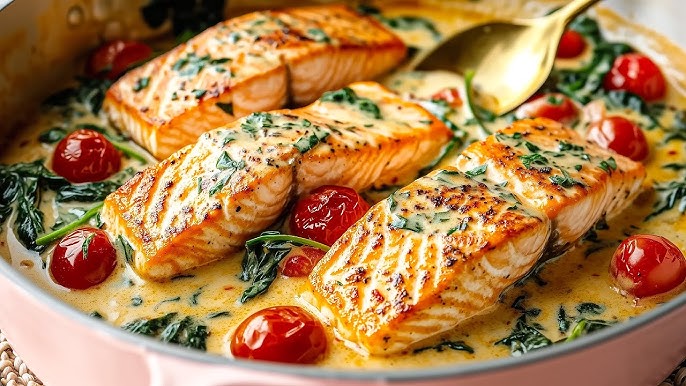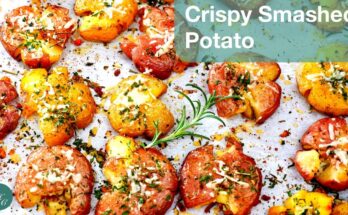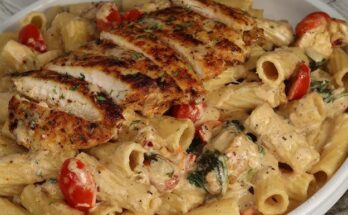Salmon Bake Recipe: Nothing beats the satisfying comfort of a perfectly baked salmon. Whether you’re cooking for your family, entertaining friends, or just craving something light and flavorful, this salmon bake recipe delivers. It’s one of those easy, go-to meals that packs a punch with its rich flavors and heart-healthy benefits.
Let’s dive into the ultimate guide to creating a salmon bake that’s not only juicy and flaky but also bursting with flavor!
Why Salmon Bake is a Crowd Favorite
When it comes to wholesome meals that don’t require a ton of work but deliver restaurant-level flavor, salmon bake is at the top of the list. It’s a dish that pleases even picky eaters and adapts well to various seasonings and accompaniments. From the natural buttery texture of the fish to its ability to soak in herbs and spices, baked salmon never fails to impress. Plus, the aroma that fills your kitchen while it’s in the oven? Irresistible.
Salmon bake is also one of the most forgiving dishes for novice cooks. Unlike pan-searing or grilling, baking gives you control over time and temperature, allowing the fish to cook evenly without drying out. This makes it perfect for busy weeknights or when you need a foolproof dish that delivers every time.
Health Benefits of Baked Salmon
Apart from taste, salmon comes with a long list of health benefits. It’s rich in omega-3 fatty acids, high-quality protein, and essential vitamins like B12 and D. Baking, as a cooking method, retains most of the nutrients without the need for added fats or oils, making it a healthier alternative to frying or sautéing.
Omega-3s play a crucial role in supporting heart health, brain function, and reducing inflammation. A regular serving of baked salmon can contribute significantly to your weekly nutritional needs. It’s especially beneficial for those looking to maintain a balanced diet without sacrificing flavor.
Essential Ingredients for a Delicious Salmon Bake
Choosing the Right Salmon
The first step to a great salmon bake starts with quality fish. Fresh or frozen – both can work, but you want to make sure it’s wild-caught if possible. Wild-caught salmon tends to be leaner, has a deeper flavor, and contains more nutrients compared to farmed varieties. Some of the best options include:
- Sockeye Salmon: Known for its deep red color and rich taste.
- Coho Salmon: Milder in flavor, great for those who prefer a subtler seafood experience.
- Atlantic Salmon: Commonly found in grocery stores, with a slightly fattier texture.
If you’re using frozen salmon, make sure to thaw it completely before baking to ensure even cooking.
Must-Have Spices and Marinades
Flavor is key, and while salmon is naturally delicious, adding the right spices and marinades elevates the entire dish. Here are some basics to have on hand:
- Salt and Pepper: Always a must to bring out the salmon’s natural flavor.
- Garlic Powder or Fresh Garlic: Adds a robust, savory kick.
- Lemon Juice or Zest: Brightens up the dish and balances the richness.
- Paprika or Smoked Paprika: For color and a smoky flavor.
- Fresh or Dried Herbs: Dill, parsley, thyme, and rosemary are all excellent choices.
- Olive Oil or Butter: Helps keep the salmon moist during baking.
You can also use ready-made marinades or create your own blend using soy sauce, honey, mustard, and fresh herbs.
Preparing the Salmon for Baking
Cleaning and Prepping the Salmon Fillet
Start by rinsing the salmon under cold water and patting it dry with paper towels. If there are any pin bones, use kitchen tweezers to remove them. Leaving the skin on is optional – it adds flavor and helps keep the fillet together during baking, but you can remove it post-bake if desired.
Next, place the salmon on a cutting board and lightly score the top (just a few shallow diagonal cuts) – this helps the marinade penetrate better and cook more evenly.
Marinating for Maximum Flavor
While not required, marinating your salmon for 15 to 30 minutes can significantly enhance its taste. A simple marinade might include olive oil, minced garlic, lemon juice, a touch of honey, and fresh herbs. Place the fillets in a resealable plastic bag or dish, coat them well, and refrigerate.
Avoid over-marinating – especially if your marinade is acidic (lemon, vinegar, etc.) – as it can start to “cook” the fish like ceviche and make it mushy.
Step-by-Step Instructions for Baking Salmon
Preheating the Oven and Setting the Temperature
Preheat your oven to 375°F (190°C). This is the sweet spot for getting tender, flaky salmon without drying it out. If your fillets are thicker, you can go a bit higher (up to 400°F), but keep an eye on the bake time.
Laying the Salmon in the Baking Dish
Choose a baking dish or sheet pan lined with parchment paper or foil for easy cleanup. Lay the salmon fillets skin-side down, spaced out to ensure even heat circulation. Drizzle any remaining marinade over the top, or add extra herbs, lemon slices, or a few pats of butter for an extra layer of flavor.
Cooking Time and Temperature Tips
Bake the salmon uncovered for about 12 to 15 minutes, depending on the thickness. A good rule of thumb is to cook salmon for 4-6 minutes per half-inch of thickness. The internal temperature should reach 145°F (63°C) at the thickest part.
To test doneness, gently press the top with a fork – the fish should flake easily and be opaque throughout. Avoid overcooking, as salmon can dry out quickly beyond its ideal temperature.
Delicious Variations of Salmon Bake
Creamy Garlic Butter Salmon
One of the most decadent takes on baked salmon is the creamy garlic butter variation. This rich and flavorful version uses a homemade garlic cream sauce that turns a simple meal into something luxurious. Start by sautéing minced garlic in butter until fragrant. Add in heavy cream, parmesan cheese, and a pinch of nutmeg for depth. Once the sauce thickens slightly, pour it over your salmon fillets before baking.
This version pairs wonderfully with steamed broccoli, mashed potatoes, or even a bed of herbed rice. The creaminess of the sauce complements the natural oils of the salmon without overpowering it, making every bite melt-in-your-mouth delicious. If you’re entertaining guests or want a restaurant-style meal at home, creamy garlic butter salmon is a total crowd-pleaser.
For an extra kick, consider adding a teaspoon of Dijon mustard to the cream sauce or a sprinkle of red chili flakes if you like a bit of heat. This variation is best baked at 375°F for 15-18 minutes to allow the sauce to bubble and slightly caramelize around the edges.
Lemon Dill Salmon Bake
If you’re after something light, zesty, and ultra-refreshing, lemon dill salmon is your go-to. This variation leans on the bright citrus of lemon and the clean, slightly grassy flavor of fresh dill. It’s perfect for summer dinners or when you want something clean-tasting but satisfying.
To prepare, lay your salmon in a baking dish, season with salt and pepper, and then drizzle with fresh lemon juice. Add lemon slices directly on top of the fillets and sprinkle generously with chopped dill. A little bit of olive oil or a few pats of butter will help keep the fish moist as it bakes.
This recipe works great with asparagus, baby potatoes, or a fresh garden salad. The lemon adds a beautiful tang that cuts through the richness of the salmon, while the dill infuses every bite with freshness. Bake at 375°F for 12-15 minutes or until the salmon flakes easily with a fork.
Mediterranean Style Salmon with Veggies
For those who love big flavors and vibrant colors, the Mediterranean-style salmon bake is unbeatable. This version incorporates cherry tomatoes, kalamata olives, red onions, and bell peppers – all tossed in olive oil, garlic, oregano, and a splash of balsamic vinegar.
Arrange your vegetables around the salmon fillets in a baking dish. Season everything with salt, pepper, and crushed red pepper for a little zing. Add lemon wedges and a few crumbles of feta cheese for that authentic Mediterranean flair.
As it bakes, the juices from the vegetables and the salmon blend into a delicious broth that’s perfect for spooning over couscous or quinoa. This is a complete one-pan meal that’s as healthy as it is beautiful. Bake at 400°F for about 20 minutes, and don’t be afraid to broil for the last 2-3 minutes to get a slight char on the veggies.
Tips for Perfecting Your Salmon Bake Every Time
Avoiding Common Mistakes
Even the simplest recipes can go awry without a little care. One of the biggest mistakes people make with baked salmon is overcooking. Salmon is a delicate fish, and even a few extra minutes in the oven can lead to a dry, tough texture. Stick to the cooking times suggested and always check for doneness with a fork or thermometer.
Another issue is not seasoning enough. Because salmon has a robust flavor, it stands up well to bold seasonings—but it still needs salt and aromatics to truly shine. Don’t shy away from herbs, citrus, or spice blends. And never forget to let your salmon come to room temperature before baking—this ensures even cooking.
Making It a One-Pan Meal
The beauty of salmon bake is how easily it turns into a one-pan dinner. Just add vegetables like green beans, asparagus, carrots, or sliced potatoes around your fillets. Toss them in a bit of olive oil, salt, and pepper before baking, and they’ll roast to perfection alongside your fish. It’s convenience and flavor all in one dish, with minimal cleanup afterward.
Storing and Reheating Leftovers
If you end up with leftovers (which is rare because it’s so delicious), store them properly. Place the baked salmon in an airtight container and refrigerate for up to 3 days. To reheat, gently warm it in the oven at 300°F for about 10 minutes, or use a microwave on medium power. Just be cautious not to overheat, as this can dry the fish out.
Salmon leftovers are also great flaked into salads, pasta dishes, or even breakfast omelets. Its versatility makes it worth saving every last bite.
What to Serve with Your Salmon Bake
Side Dishes That Complement Salmon
Wondering what goes well with a salmon bake? Here are some go-to sides that elevate your meal:
- Roasted Veggies: Asparagus, Brussels sprouts, or carrots add color and nutrition.
- Grains: Wild rice, quinoa, or couscous soak up the salmon’s juices beautifully.
- Salads: A simple arugula or cucumber salad with vinaigrette keeps the meal light and fresh.
- Potatoes: Mashed, roasted, or scalloped potatoes pair wonderfully with creamy salmon recipes.
Sauces and Condiments to Try
Even though baked salmon is full of flavor, the right sauce can take it over the top. Try:
- Tzatziki or Yogurt Dill Sauce: Perfect for Mediterranean-style salmon.
- Honey Mustard Glaze: Adds a sweet and tangy finish.
- Avocado Crema: Creamy and cool, great with spicy salmon bakes.
Serving your salmon with one of these flavorful additions ensures variety and enhances the experience.
Salmon Bake for Special Occasions
Holiday Meals and Family Gatherings
Salmon bake isn’t just a weeknight winner—it also makes a standout dish for special occasions. Hosting a dinner party? Preparing a celebratory meal? A beautifully baked salmon garnished with herbs, lemon slices, and colorful veggies can act as a stunning centerpiece. It’s elegant, yet simple to prepare.
Plus, it’s a thoughtful option for guests who may be avoiding red meat or are looking for something lighter. You can easily make a large tray of baked salmon fillets to serve a crowd, and the flavors can be tailored to suit a wide variety of palates.
Meal Prep and Weekly Planning
If you’re into meal prepping, salmon bake is a smart choice. It stores well, heats up nicely, and fits into nearly any dietary plan—low-carb, keto, gluten-free, or high-protein. Bake a few fillets at once, pair with different sides throughout the week, and you’ve got lunch or dinner handled for days.
It’s efficient, budget-friendly, and keeps your diet diverse and exciting.
FAQs about Salmon Bake Recipe
1. Can I use frozen salmon for baking?
Yes, absolutely! Just make sure to thaw it completely in the fridge overnight and pat it dry before baking.
2. How do I know when the salmon is done baking?
The salmon should flake easily with a fork and have an internal temperature of 145°F (63°C). The flesh will turn opaque.
3. What’s the best type of salmon for baking?
Wild-caught varieties like sockeye or coho are ideal due to their flavor and texture, but Atlantic salmon works well too.
4. Is it better to bake salmon covered or uncovered?
Bake it uncovered to allow the top to cook evenly and develop a light crust. Covering can cause it to steam.
5. How can I add extra flavor to a plain salmon bake?
Use a marinade with herbs, lemon, garlic, and olive oil—or top with a sauce like creamy dill or spicy mustard before baking.
Conclusion
The salmon bake is more than just a recipe—it’s a kitchen essential. It’s the kind of meal that ticks all the boxes: easy, healthy, flavorful, and adaptable. Whether you’re going for a quick weeknight dinner, a vibrant Mediterranean twist, or a creamy garlic feast, baked salmon always delivers.
So next time you’re staring into the fridge wondering what to cook, remember that a perfectly baked salmon is only a few simple steps away.



